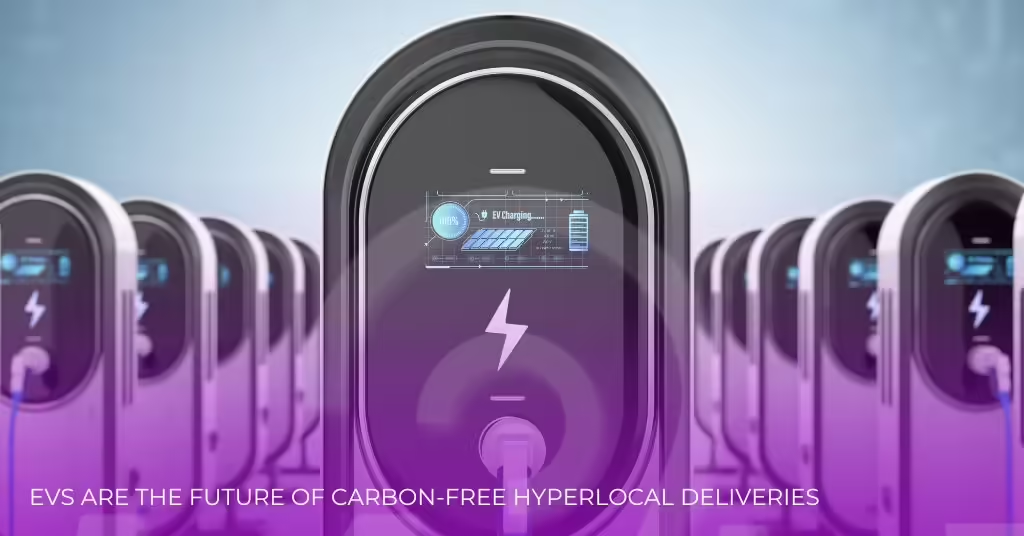EVs: The Future of Carbon-Free Hyperlocal Deliveries
This blog post discusses how businesses are shifting to electric vehicles for carbon-free hyperlocal deliveries and faster, eco-friendlier order fulfillment.
In the aftermath of the COVID-19 pandemic, rapid digitization, changing consumer preferences, and the unstoppable expansion of eCommerce have all led to an unprecedented surge in the delivery industry around the world. Logistics companies are spending a lot of money on cutting-edge infrastructure, new technologies, and a trained workforce to speed up their delivery cycles and maintain their competitive edge.
Alongside that, the past couple of years have seen a massive corresponding growth in demand for same-day and next-day deliveries, dynamic on-demand services, and hyperlocal shopping. Convenience is now the primary determinant of customer satisfaction, hence the greater need for fast, efficient, and reliable delivery operations.
While this is great for the hyperlocal ecosystem in general, the accompanying carbon footprint is a rising concern. Of late, there has been a notable increase in the number of vehicles on the road for home deliveries, leading to higher carbon emissions and greater fuel consumption. It is projected that the rising demand for hyperlocal deliveries will result in a 36% increase in delivery vehicles in the top 100 global suburbs by 2030. As good as it sounds, this will potentially escalate carbon emissions unless effective measures are implemented.
For businesses engaged in hyperlocal deliveries, whether in retail, e-commerce, direct-to-consumer sales, third-party logistics, food and grocery deliveries, or home services, efficient logistics are crucial for market success. However, as socially responsible entities, these businesses also have an obligation to mitigate the environmental impact of their logistical activities and build sustainable supply chains.
Thankfully, many hyperlocal fleet operators are adopting green logistics practices to reduce their carbon footprint. This shift towards sustainability aims to balance the need for efficient hyperlocal operations with the responsibility to protect the planet.
Although green logistics is expected to be at the center of the logistics revolution, new market entrants can also possibly benefit from other growth drivers like the AI-powered zone assignment, auto-dispatch, and predictive analytics to offer smart, end-to-end solutions, all while cutting costs and environmental harm.
4 Key Benefits of Electric Fleets in Hyperlocal Delivery
This goes without saying—adopting electric fleets offers a superior solution for organizations aiming to improve urban mobility and logistics management. The use of electric fleets in hyperlocal delivery provides several advantages:
Reduced Carbon Emissions
Transportation is the world’s largest source of climate pollution. To address the climate crisis, it’s essential to make vehicles on our roads as clean as possible. Carbon emissions from fuel-powered vehicles cause lifelong respiratory and cardiovascular problems like asthma, chronic bronchitis, stroke, and cancer. These diseases can result in premature death, if left uncured. Studies by reputable universities, such as Harvard and Oxford, have repeatedly revealed the severe health and social costs of vehicle emissions.
In short, each gallon of gasoline or diesel has associated health and environmental costs, making the shift to EVs a pivotal step for both our planet and public health. Regardless of the type of power grid used to charge it, an EV generally produces lower greenhouse gas emissions than its fuel-powered counterparts due to their efficiency in converting energy to power. When more countries transition to cleaner energy sources, the environmental benefits of EVs will definitely be more obvious.
Substantial Cost Savings
Operating an electric fleet results in significantly lower fuel and energy expenses per mile compared to traditional internal combustion engines (ICEs). EVs have fewer moving parts than ICEs, which means lower repair and maintenance costs. However, they still require regular upkeep, including tires, brakes, as well as occasional battery repair or replacement. They also have regenerative brakes and use single-speed transmission to manage the electric motor. Both these features make EVs less prone to wear and tear, further enhancing their economic value.
Moreover, most countries offer two key tax benefits for EVs: state aid for vehicle purchases and lower employee taxation, both of which, when combined, lower the upfront cost of an EV by up to 50% of that of an ICE.
Better Brand Perception
A recent study from Ladoke Akintola University of Technology suggests that there are many upsides to investing in green logistics practices. Other than reducing emissions of greenhouse gasses and other pollutants during transportation, it also improves the overall efficiency by streamlining operations and optimizing routes. This results in faster, more seamless order fulfillment, which eventually translates into increased customer satisfaction. Furthermore, as consumers place a greater emphasis on sustainability in their decision-making processes, adopting electric fleets to ensure carbon-free hyperlocal deliveries logistics lead to an improvement in corporate reputation and brand value. This shift also reflects a brand’s commitment to corporate responsibility and a more sustainable future.
Business Growth Opportunity
Post-pandemic, the demand for same-day delivery has increased rapidly. According to Statista projections, the market size for this type of delivery, whereby a parcel is delivered within a calendar day or within a scheduled time window, will grow at a CAGR of 42% between 2021 and 2027.
This sector’s huge potential for business growth is the primary reason why companies are increasingly focusing on adding hyperlocal deliveries to their service portfolio because of the numerous benefits they stand to gain from this business model. Walmart is a good case in point.
In addition to their traditional fulfillment centers, Walmart now runs a network of 31 dedicated eCommerce fulfillment centers and 4,700 stores located strategically within 10 miles of 90% of the U.S. population to fulfill online orders quickly and efficiently. Also, by leveraging the extensive coverage provided by their stores, they are able to offer same-day, next-day, and scheduled delivery to 80% of the U.S. population.
EVs will undoubtedly improve their services by offering quicker and more efficient deliveries than traditional fossil-fueled vehicles. Electric bikes, for example, have the ability to navigate urban areas quickly, and their reduced need for frequent refueling allows for faster delivery times and makes them the vehicle of choice for hyperlocal logistics.
Are EVs the Future of Carbon-Free Hyperlocal Delivery?
Yes, most definitely. There’s greater pressure on governments to quicken decarbonization, because of which they are making aggressive energy policies to switch to energy-efficient resources, optimize carbon-intensive processes, and achieve net-zero emissions. They are also inclined to penalize the purchase of ICEs and encourage that of EVs. This means that it is highly likely that we’ll see more and more EVs fulfilling hyperlocal deliveries to our doorsteps.
Although the initial infrastructure investment is considerable, the long-term returns can be twice the upfront cost. That being said, one must not forget that the shift towards EVs in hyperlocal delivery is not only a response to increasing tax regulations on fuel-powered vehicles but also a strategic move to meet consumer demand for faster and more sustainable delivery options. The transition to EVs should, by all means, support the broader goal of reducing carbon footprints and achieving sustainability in the transportation sector.

